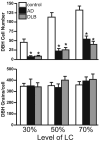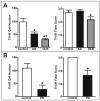Differential response of the central noradrenergic nervous system to the loss of locus coeruleus neurons in Parkinson's disease and Alzheimer's disease
- PMID: 21147074
- PMCID: PMC3038670
- DOI: 10.1016/j.brainres.2010.12.015
Differential response of the central noradrenergic nervous system to the loss of locus coeruleus neurons in Parkinson's disease and Alzheimer's disease
Abstract
In Parkinson's disease (PD), there is a significant loss of noradrenergic neurons in the locus coeruleus (LC) in addition to the loss of dopaminergic neurons in the substantia nigra (SN). The goal of this study was to determine if the surviving LC noradrenergic neurons in PD demonstrate compensatory changes in response to the neuronal loss, as observed in Alzheimer's disease (AD). Tyrosine hydroxylase (TH) and dopamine β-hydroxylase (DBH) mRNA expression in postmortem LC tissue of control and age-matched PD subjects demonstrated a significant reduction in the number of noradrenergic neurons in the LC of PD subjects. TH mRNA expression/neuron did not differ between control and PD subjects, but DBH mRNA expression/neuron was significantly elevated in PD subjects compared to control. This increase in DBH mRNA expression in PD subjects is not a response to neuronal loss because the amount of DBH mRNA expression/neuron in AD subjects was not significantly different from control. Norepinephrine transporter (NET) binding site concentration in the LC of PD subjects was significantly reduced over the cell body region as well as the peri-LC dendritic zone. In PD subjects, the loss of dendrites from surviving noradrenergic neurons was also apparent with TH-immunoreactivity (IR). This loss of LC dendritic innervation in PD subjects as measured by TH-IR was not due to LC neuronal loss because TH-IR in AD subjects was robust, despite a similar loss of LC neurons. These data suggest that there is a differential response of the noradrenergic nervous system in PD compared to AD in response to the loss of LC neurons.
Published by Elsevier B.V.
Figures






Similar articles
-
Compensatory changes in the noradrenergic nervous system in the locus ceruleus and hippocampus of postmortem subjects with Alzheimer's disease and dementia with Lewy bodies.J Neurosci. 2006 Jan 11;26(2):467-78. doi: 10.1523/JNEUROSCI.4265-05.2006. J Neurosci. 2006. PMID: 16407544 Free PMC article.
-
Differential modification of dopamine transporter and tyrosine hydroxylase mRNAs in midbrain of subjects with Parkinson's, Alzheimer's with parkinsonism, and Alzheimer's disease.Mov Disord. 1997 Nov;12(6):885-97. doi: 10.1002/mds.870120609. Mov Disord. 1997. PMID: 9399211
-
Microstructural integrity of the locus coeruleus and its tracts reflect noradrenergic degeneration in Alzheimer's disease and Parkinson's disease.Transl Neurodegener. 2024 Feb 9;13(1):9. doi: 10.1186/s40035-024-00400-5. Transl Neurodegener. 2024. PMID: 38336865 Free PMC article.
-
Biochemistry of postmortem brains in Parkinson's disease: historical overview and future prospects.J Neural Transm Suppl. 2007;(72):113-20. doi: 10.1007/978-3-211-73574-9_14. J Neural Transm Suppl. 2007. PMID: 17982884 Review.
-
Common factors among Alzheimer's disease, Parkinson's disease, and epilepsy: possible role of the noradrenergic nervous system.Epilepsia. 2012 Jun;53 Suppl 1:61-6. doi: 10.1111/j.1528-1167.2012.03476.x. Epilepsia. 2012. PMID: 22612810 Review.
Cited by
-
Research progress on neuromolecular imaging of REM sleep behavior disorder.Front Neurol. 2022 Oct 10;13:1009907. doi: 10.3389/fneur.2022.1009907. eCollection 2022. Front Neurol. 2022. PMID: 36299269 Free PMC article. Review.
-
Noradrenergic terminals regulate L-DOPA-derived dopamine extracellular levels in a region-dependent manner in Parkinsonian rats.CNS Neurosci Ther. 2014 Jul;20(7):671-8. doi: 10.1111/cns.12275. Epub 2014 Apr 28. CNS Neurosci Ther. 2014. PMID: 24775184 Free PMC article.
-
Relationships of in vivo brain norepinephrine transporter and age, BMI, and gender.Synapse. 2023 Sep;77(5):e22279. doi: 10.1002/syn.22279. Epub 2023 Jun 29. Synapse. 2023. PMID: 37382240 Free PMC article.
-
Effects of noradrenergic denervation on L-DOPA-induced dyskinesia and its treatment by α- and β-adrenergic receptor antagonists in hemiparkinsonian rats.Pharmacol Biochem Behav. 2012 Jan;100(3):607-15. doi: 10.1016/j.pbb.2011.09.009. Epub 2011 Sep 25. Pharmacol Biochem Behav. 2012. PMID: 21978941 Free PMC article.
-
Vascular degeneration in Parkinson's disease.Brain Pathol. 2013 Mar;23(2):154-64. doi: 10.1111/j.1750-3639.2012.00628.x. Epub 2012 Sep 13. Brain Pathol. 2013. PMID: 22897695 Free PMC article.
References
-
- Adolfsson R, Gottfries CG, Roos BE, Winblad B. Changes in the brain catecholamines in patients with dementia of Alzheimer's type. Br J Psychiatry. 1979;135:216–223. - PubMed
-
- Arai A, Tomiyama M, Kannari K, Kimura T, Suzuki C, Watanabe M, Kawarabayashi T, Shen H, Shoji M. Reuptake of L-DOPA-derived extracellular DA in the striatum of a rodent model of Parkinson's disease via norepinephrine transporter. Synapse. 2008;62:632–635. - PubMed
-
- Ballard C, Holmes C, McKeith I, Neill D, O'Brien J, Cairns N, Lantos P, Perry E, Ince P, Perry R. Psychiatric morbidity in dementia with Lewy bodies: a prospective clinical and neuropathological comparative study with Alzheimer's disease. Am J Psychiatry. 1999;156:1039–1045. - PubMed
-
- Barber R, Panikkar A, McKeith IG. Dementia with Lewy bodies: diagnosis and management. Int J Geriatr Psychiatry. 2001;16:S12–S18. - PubMed
Publication types
MeSH terms
Substances
Grants and funding
LinkOut - more resources
Full Text Sources
Medical
Miscellaneous

